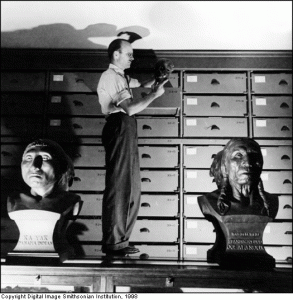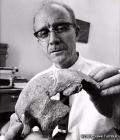
December 27, 2010
The anthropologist who was interviewed in David L. Wolper’s Monsters! Mysteries or Myths? (1974) is relatively unknown today.

T. Dale Stewart was quoted in Wolper’s documentary as an example of a mainstream anthropologist’s view on Bigfoot. Here is what he had to say:
“Eyewitness testimony in the case of Bigfoot I don’t think is very good because you can’t test it. It’s credibility of the person and these people…they want to see something strange, they can imagine it. I don’t believe in Bigfoot because no hard evidence has been presented. All the evidence so far is in the form of footprints and such reports–all of which constitute soft evidence…Hard evidence is like [a] skull.”

Stewart died in 1997. He was an interesting character, and folks might enjoy knowing a little more background about him. His published obituary of the time highlighted his achievements.

T. Dale Stewart Dies at 96; Anthropologist at Smithsonian
By ERIC PACE
New York Times: October 30, 1997T. Dale Stewart, a physical anthropologist who was an authority on human bones, died on Monday in a nursing home in Bethesda, Md. He was 96 and a longtime resident of McLean, Va.
Dr. Stewart went to work for the Smithsonian Institution in 1924. After time out to earn a medical degree from Johns Hopkins University, he rose to be the director of the Smithsonian’s National Museum of Natural History from 1962 to 1965. In theory, he retired from the Smithsonian in 1971, but he continued working there for more than two decades.
Denis Stanford, an archeologist who is chairman of the museum’s anthropology department, said yesterday: ”Modern physical anthropology has been significantly influenced by his work. He was a broad thinker and a precise scientist. He would only work on one small project at a time and really milk everything he could out of it from an analytical point of view.”
In 1960, while Dr. Stewart was a curator at the museum, he reported that evidence had been found that early modern man had lived side by side with Neanderthals in the Middle East.
Dr. Stewart said the two species evidently lived in the same caves — but not simultaneously — and existed as distinctly isolated populations that might even have waged war against each other.
Those possibilities were suggested by studies that Dr. Stewart had made of skulls and other bones that had been removed from Shanidar cave in Iraq and earlier from two caves 600 miles to the southwest, on Mount Carmel in what was then Palestine. He reported on those studies in an article in the journal Science in 1960.
The relationship between Neanderthal man and modern man is currently the subject of lively discussion in the scientific world, and Dr. Stanford said, ”It is true that they likely lived side by side, as Dale suggested.”
Dr. Stewart indicated the breadth of his thinking in a 1985 interview. Asked to describe his field of expertise, he answered crisply, ”Mankind.”
He was also called on to apply his expertise to the study of modern bones. After a man’s bones were found in Manassas, Va., at the bottom of a well, Dr. Stewart discovered evidence from which he concluded that the man had been a bootlegger during Prohibition and that because proof of his death had been lacking, his assailant was never caught.
The Pentagon also asked him to help identify the war dead in Korea. And when the Army found a mass grave in Europe and wanted to know whether it stemmed from a modern atrocity, he applied his analytical skills and demonstrated that, as he put it, ”they’re bones from the Franco-Prussian War.”
Dr. Stewart was born and reared in Delta, Pa., where his parents operated a pharmacy. As a boy, he loved unearthing arrowheads and fragments of Indian pottery along the Susquehanna River. He received a bachelor’s degree in 1927 from George Washington University while working for the Smithsonian. He received his medical degree in 1931.
He married Julia C. Wright in 1932; she died in 1951. He married Rita Frame Dewey in 1952, and she died in 1996.
His survivors include a daughter, Cornelia Gill of McLean; three grandchildren, and seven great-grandchildren.
About Loren Coleman
Loren Coleman is one of the world’s leading cryptozoologists, some say “the” leading living cryptozoologist. Certainly, he is acknowledged as the current living American researcher and writer who has most popularized cryptozoology in the late 20th and early 21st centuries.
Starting his fieldwork and investigations in 1960, after traveling and trekking extensively in pursuit of cryptozoological mysteries, Coleman began writing to share his experiences in 1969. An honorary member of Ivan T. Sanderson’s Society for the Investigation of the Unexplained in the 1970s, Coleman has been bestowed with similar honorary memberships of the North Idaho College Cryptozoology Club in 1983, and in subsequent years, that of the British Columbia Scientific Cryptozoology Club, CryptoSafari International, and other international organizations. He was also a Life Member and Benefactor of the International Society of Cryptozoology (now-defunct).
Loren Coleman’s daily blog, as a member of the Cryptomundo Team, served as an ongoing avenue of communication for the ever-growing body of cryptozoo news from 2005 through 2013. He returned as an infrequent contributor beginning Halloween week of 2015.
Coleman is the founder in 2003, and current director of the International Cryptozoology Museum in Portland, Maine.
Filed under Bigfoot, Cryptomundo Exclusive, CryptoZoo News, Cryptozoology, Pop Culture, Sasquatch, Skeptical Discussions, Television